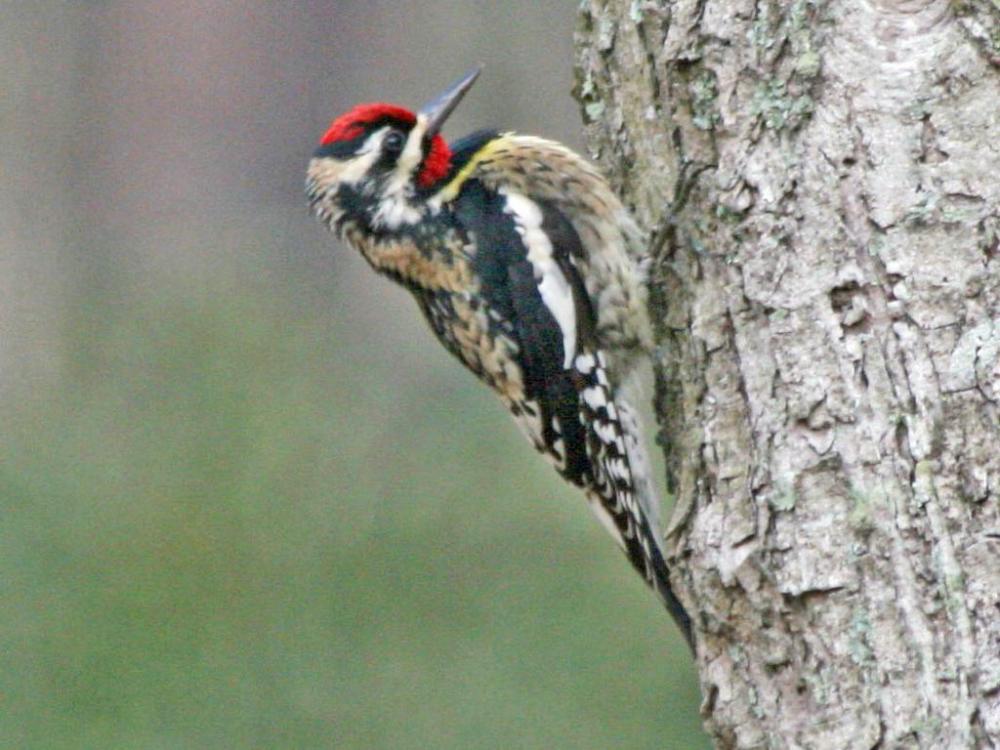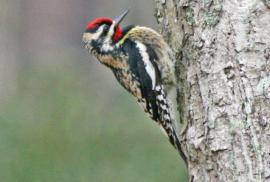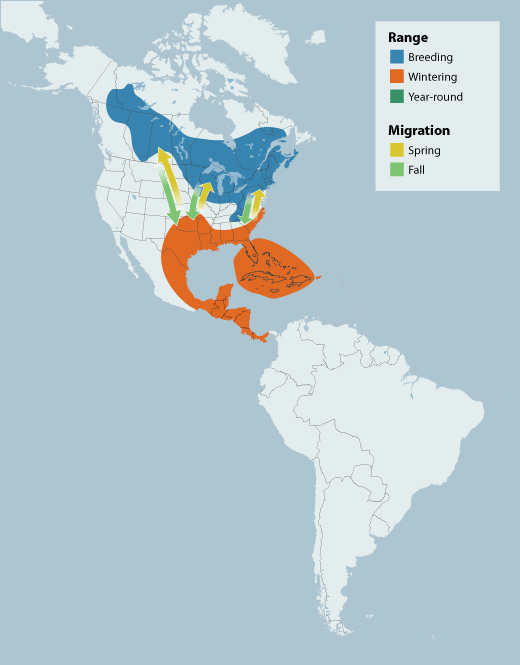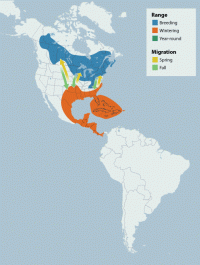Guide to Boreal Birds
This is an in-depth boreal species profile.
What is this?
This species is one of more than 30 birds selected for in-depth profiles. Find out why and see all selected boreal birds »
Overview
Many people think the Yellow-bellied Sapsucker is a mythical bird because its name is often used to parody bird names. It is not only real, it is in some ways a keystone species. Like all woodpeckers, it excavates nest cavities that subsequently are used by a wide variety of animals, from other birds to squirrels and spiders. Sapsuckers also drill sap wells from which other animals obtain nutritious sap and the insects attracted to it. Sapsuckers get their name from their habit of boring holes into the cambium layer or inner bark, letting the sap exude and run down the trunk. The birds wipe up or suck the oozing sap with their brush-like tongues. They return again and again to the same tree and also consume the insects attracted to the sap. Hummingbirds often nest near sap wells, follow sapsuckers, and even time their migration to coincide with that of sapsuckers. The Red-breasted and Red-naped Sapsuckers were once considered part of this species; the three are now considered a superspecies, and there is much hybridization. This species, at least on migration, is the quietest of the woodpeckers; aside from a few squeaks and whines, it is mainly silent. It is also the least conspicuous, hitching around to the opposite side of the tree trunk when approached.
Description
8 1/2" (22 cm). A furtive woodpecker mottled with off-white and black; male has red crown and throat; female has only red crown. Both sexes dull yellowish below. Immatures dull brown. In all plumages, distinctive mark is conspicuous white wing stripe, visible both at rest and in flight. Similar to Red-naped Sapsucker, but male lacks red nape patch, and red throat is enclosed by black; throat of female all white. Hybridizes with Red-naped in Rocky Mountains, where puzzling intermediates can be found.
Voice
Mewing and whining notes.
Nesting
5 or 6 white eggs in a tree cavity excavated by the birds.
Habitat
Like most woodpeckers, the Yellow-bellied Sapsucker is primarily a forest and woodland species. Like other sapsuckers, it tends to favor early successional and riparian habitats much of the time. On the breeding grounds, aspen, maple, and birch stands are the most frequently used habitats. It often occurs in very young forests following large-scale logging operations that remove the dense, coniferous climax forest. On migration and in winter, it is found in a broader range of vegetation types, including orchards, palm groves, scrub, and towns. Bottomland hardwoods are widely used when available.
Range/Migration
Southward migration begins in September, females departing first and adult males last. Migration is primarily well east of the Rocky Mountains, mostly at night and often in flocks. Males typically winter in the U.S., from Kansas and Long Island south, while most females travel to the West Indies, Mexico, and Central America; birds at the northern edge are virtually all male and those at the southern extreme female. Spring migration is essentially a mirror image of fall migration. Males typically arrive on the breeding grounds by late March in the south, early May in the north.
Breeding
The breeding range of the Yellow-bellied Sapsucker covers most of the boreal zone from east-central Alaska to southern Newfoundland. It dips south into northeastern Iowa and western Maryland, with isolated populations in the Alleghenies and Smokies. Canada's boreal forests support roughly 55% of the population. Males arrive about a week ahead of females and establish territories by means of the drumming cadence distinctive of sapsuckers: a short roll followed by a pause and then several individual strikes or abbreviated rolls. Both sexes often return to the previous year's nest territory, so re-pairings are common. They often use the same tree and sometimes the same cavity. Males do almost all the excavation of new cavities, over a period of 7-20 days; females contribute more when time is short, such as after failed nest attempts. Cavities are most often in diseased deciduous trees, especially quaking aspen infected with heartwood decay fungus. The four to six eggs are incubated by both sexes for 10-13 days and the young fledge over a 2-3 day period at 25-30 days of age. The parents lure the young out of the nest with food, and the fledglings do not reenter the cavity. Family groups remain together near sap wells, the young gradually learning to feed themselves, first on sap and later on insects. There is only one brood per year.
Diet/Feeding Behavior
The sapsuckers' feeding behavior is the most distinctive feature of their ecology. Sap, directly or indirectly, contributes significantly to their diet, and most of their foraging time is spent creating, maintaining, inspecting, and feeding from sap wells. Sap itself makes up only about 20% of the overall diet of this species, though at certain times, the figure can be 100%. Sap is consumed for its sugar, which varies in content by tree species and season; trees are selected based more on sugar content than on sap flow. Higher amino acid content in the sap of trees entering senescence may make such trees attractive. Sap is consumed more when its sugar content is higher and when the birds' energetic needs are higher, such as during molt. Wells usually are dug into phloem tissues, which are closer to the surface; during early spring, however, the underlying xylem tissues have higher sugar content (to fuel leaf growth), and sapsuckers drill through the phloem to reach them. Phloem wells begin as slits and gradually are widened into rectangles; xylem wells are round holes. Sapsuckers vigorously defend their wells against conspecifics, other birds, and even many insects that might be considered food under other circumstances. Most of the remainder of the diet consists of insects, especially ants (34% of the total diet and 68% of the summer diet); most are exposed by flaking off bark or caught in flight near sap wells but some are collected from the wells themselves. Sometimes insects are dipped into the sap. Sapsuckers also consume fruit, seeds, leaf buds, and, perhaps incidentally, some bast.
References
Foster, W. I., and J. Tate, Jr. 1966. The activities and coactions of animals at sapsucker trees. Living Bird 5:87-113.
Howell, T. R. 1953. Racial and sexual differences in migration in Sphyrapicus varius. Auk 70:118-126.
Lawrence, L. de K. 1967. A comparative life-history study of four species of woodpeckers. Ornithol. Monogr. 5.
Sauer, J. R., J. E. Hines, and J. Fallon. 2004. The North American Breeding Bird Survey, Results and Analysis 1966 - 2003. Version 2004.1. USGS Patuxent Wildlife Research Center, Laurel, MD.
Short, L. L. 1982. Woodpeckers of the world. Delaware Mus. Nat. Hist., Monogr. Ser. 4, Greenville, DE.
Walters, E. L., E. H. Miller, and P. E. Lowther. 2002. Yellow-bellied Sapsucker (Sphyrapicus varius). In The Birds of North America, No. 662 (A. Poole and F. Gill, eds.). The Birds of North America, Inc., Philadelphia, PA.
Credits
Birding content provided by National Wildlife Federation/eNature, with support from Ducks Unlimited/The Pew Charitable Trusts.





